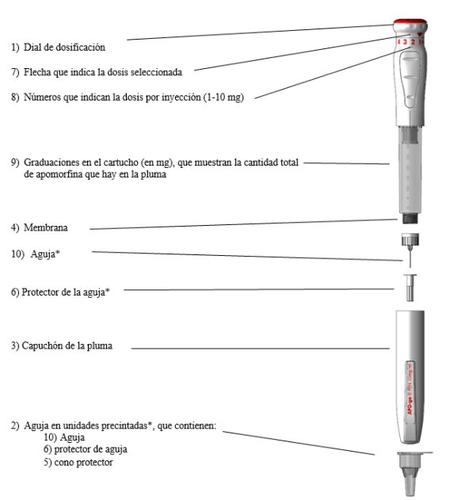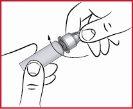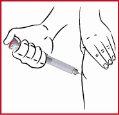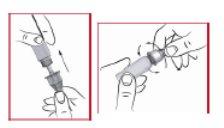

АПО-ГО ПЕН 10 мг/мл ІН'ЄКЦІЙНИЙ РОЗЧИН

Запитайте лікаря про рецепт на АПО-ГО ПЕН 10 мг/мл ІН'ЄКЦІЙНИЙ РОЗЧИН

Інструкція із застосування АПО-ГО ПЕН 10 мг/мл ІН'ЄКЦІЙНИЙ РОЗЧИН
Введення
Опис: Інформація для користувача
APO-go PEN 10 мг/мл розчин для ін'єкційГідрохлорид апоморфіну
(* У тексті скорочено до APO-go)
Для застосування у дорослих
Прочитайте уважно весь опис перед тим, як почнете використовувати цей препарат, оскільки він містить важливу інформацію для вас.
- Збережіть цей опис, оскільки вам може знадобитися знову його прочитати.
- Якщо у вас є якісь питання, проконсультуйтеся з вашим лікарем, медсестрою або фармацевтом.
- Цей препарат призначений лише для вас і не слід давати його іншим людям, навіть якщо вони мають такі самі симптоми, оскільки це може їм нашкодити.
- Якщо ви відчуваєте побічні ефекти, проконсультуйтеся з вашим лікарем або фармацевтом, навіть якщо ці побічні ефекти не вказані в цьому описі. Див. розділ 4.
Зміст опису:
- Що таке APO-go Pen і для чого він використовується.
- Що потрібно знати перед тим, як почати використовувати APO-go Pen.
- Як використовувати APO-go Pen.
- Можливі побічні ефекти.
- Зберігання APO-go Pen.
- Зміст упаковки та додаткова інформація.
1. Що таке APO-go Pen і для чого він використовується
APO-go Pen містить розчин для ін'єкцій апоморфіну, який вводиться під шкіру (підшкірно). Активний інгредієнт APO-go Pen - гідрохлорид апоморфіну. Кожен мілілітр розчину містить 10 мг апоморфіну.
Гідрохлорид апоморфіну належить до групи препаратів, відомих як дофамінергічні агоністи. APO-go Pen використовується для лікування хвороби Паркінсона. Апоморфін допомагає зменшити час у стані "off" або стан нерухомості у пацієнтів, які раніше лікувалися леводопою і/або іншими дофамінергічними агоністами для лікування хвороби Паркінсона. Ваш лікар або медсестра допоможуть вам розпізнати ознаки, які вказуватимуть, коли вам потрібно використовувати цей препарат.
Незважаючи на назву препарату, апоморфін не містить морфіну.
2. Що потрібно знати перед тим, як почати використовувати APO-go PEN
Перед тим, як використовувати APO-go Pen, ваш лікар проведе ЕКГ (електрокардіограму) і попросить список усіх інших препаратів, які ви приймаєте. Ця ЕКГ буде повторена в перші дні лікування і в будь-який момент, коли ваш лікар вважатиме це необхідним. Також він запитає про інші захворювання, які ви можете мати, особливо пов'язані з серцем. Можливо, деякі з цих запитань і додаткових досліджень будуть повторені під час кожної відвідування лікаря. Якщо у вас є симптоми, які можуть бути пов'язані з серцем, наприклад, серцебиття, обморок або головокружіння, ви повинні повідомити про це вашому лікарю негайно. Якщо у вас є діарея або ви починаєте використовувати новий препарат, ви також повинні повідомити про це вашому лікарю.
Не використовуйте APO-go Pen, якщо:
- вам менше 18 років
- у вас є труднощі з диханням
- у вас є деменція або хвороба Альцгеймера
- у вас є певне психічне захворювання, яке супроводжується симптомами, такими як галюцинації, марення, сплутаність або втрата контакту з реальністю
- у вас є проблеми з печінкою
- у вас є важка дискінезія (неконтрольовані рухи) або важка дистонія (неспроможність рухатися) незважаючи на прийом леводопи
- ви алергічні на апоморфін або будь-який інший компонент цього препарату (перелічені в розділі 6).
- ви або хтось з вашої сім'ї має порушення електрокардіограми (ЕКГ), яке називається "синдромом довгого інтервалу QT".
- - ви приймаєте ондансетрон (препарат, який використовується для лікування нудоти та блювоти).
Попередження та застереження
Проконсультуйтеся з вашим лікарем, фармацевтом або медсестрою перед тим, як почати використовувати APO-go Pen, якщо:
- у вас є проблеми з нирками
- у вас є проблеми з легенями
- у вас є проблеми з серцем
- у вас є низький кров'яний тиск або ви відчуваєте слабкість або головокружіння при встанні
- ви приймаєте інші препарати для лікування високого кров'яного тиску
- у вас є нудота або блювота
- хвороба Паркінсона викликає у вас певні психічні проблеми, такі як галюцинації та сплутаність
- ви старші або відчуваєте слабкість.
Повідомте вашому лікарю, якщо ви або ваші родичі/опіки спостерігають, що ви розвиваєте імпульси або бажання вести себе незвичайно для вас і не можете опиратися цьому імпульсу, поштовху або спокусі здійснювати певні дії, які можуть бути шкідливими для вас або інших. Ці поведінки називаються порушеннями контролю над імпульсами і можуть включати залежність від гри, надмірне споживання їжі або витрачання коштів, підвищене сексуальне бажання або збільшення сексуальних думок чи почуттів. Ваш лікар може потребувати коригування або переривання вашої дози.
Деякі пацієнти розвивають симптоми залежності, які призводять до kompulsивного бажання споживати високі дози APO-go Pen та інших препаратів, які використовуються для лікування хвороби Паркінсона.
Якщо з вами трапляється будь-яка з цих ситуацій, будь ласка, повідомте про це вашому лікарю або медсестрі.
Діти та підлітки
APO-go Pen не слід використовувати у дітей та підлітків молодше 18 років.
Використання APO-go Pen та інших препаратів
Повідомте вашому лікарю або фармацевту, якщо ви приймаєте, нещодавно приймали або можете приймати будь-який інший препарат.
Проконсультуйтеся з вашим лікарем або фармацевтом перед тим, як приймати цей препарат, якщо:
- ви використовуєте препарати, які змінюють частоту серцевих скорочень. Це включає препарати, які використовуються для лікування проблем з ритмом серця (наприклад, хінідин та аміодарон), для лікування депресії (наприклад, трициклічні антидепресанти, такі як амітріптилін та іміпрамін) та для лікування бактеріальних інфекцій (антібіотики "макроліди", такі як еритроміцин, азитроміцин та кларитроміцин) та домперидон.
- - ви приймаєте ондансетрон (препарат, який використовується для лікування нудоти та блювоти), оскільки це може призвести до важких знижень кров'яного тиску та втрати свідомості.
Якщо ви використовуєте цей препарат одночасно з іншими препаратами, ефект цих препаратів може змінитися. Це відбувається особливо з:
- препаратами, такими як клозапін, для лікування психічних розладів
- препаратами для зниження кров'яного тиску
- іншими препаратами, які використовуються для лікування хвороби Паркінсона.
Ваш лікар повідомить вам, чи потрібно змінити дозу апоморфіну або будь-якого іншого препарату, який ви приймаєте.
Якщо ви приймаєте леводопу (інший препарат для лікування хвороби Паркінсона) поряд з APO-go Pen, ваш лікар повинен регулярно проводити аналіз крові.
Використання APO-go Pen з їжею та напоями
Їжа та напої не впливають на дію цього препарату.
Вагітність та лактація
APO-go Pen не слід використовувати під час вагітності, якщо тільки це не абсолютно необхідно.
Якщо ви вагітні або перебуваєте у період лактації, вважаєте, що можете бути вагітною або плануєте завагітніти, проконсультуйтеся з вашим лікарем або фармацевтом перед тим, як використовувати цей препарат.
Не відомо, чи виділяється APO-go Pen з грудним молоком. Проконсультуйтеся з вашим лікарем, якщо ви перебуваєте у період лактації або плануєте його розпочати. Ваш лікар пояснить, чи потрібно продовжувати або припиняти лактацію, а також чи потрібно продовжувати приймати цей препарат або припиняти його.
Проконсультуйтеся з вашим лікарем або фармацевтом перед тим, як використовувати будь-який препарат.
Водіння та використання машин
APO-go Pen може викликати сонливість та сильне бажання спати. Ви не повинні водити транспортні засоби чи використовувати машини, якщо цей препарат викликає в вас такий ефект.
APO-go Pen містить сульфіт натрію:APO-go Pen містить сульфіт натрію (E-222), який рідко може викликати важкі алергічні реакції з симптомами, такими як висип, свербіж шкіри, труднощі з диханням, набухання повік, обличчя чи губ, запалення або червоність язика. Якщо ви відчуваєте ці побічні ефекти, негайно зверніться до найближчої лікарні.
APO-go Pen містить менше 23 мг (1 ммоль) натрію на 10 мл, тому він вважається практично "безнатрієвим".
3. Як використовувати APO-go PEN
Перед тим, як використовувати APO-go Pen, ваш лікар перевірить, чи ви переносите цей препарат і препарат проти нудоти, який потрібно приймати одночасно.
Слідуйте точно інструкціям з застосування цього препарату, вказаним вашим лікарем або фармацевтом. У разі сумнівів проконсультуйтеся з вашим лікарем або фармацевтом знову.
Ви повинні приймати домперидон щонайменше 2 дні перед тим, як використовувати APO-go Pen, щоб уникнути нудоти чи блювоти.
Не використовуйте APO-go Pen, якщо:
- розчин став зеленим кольором
- розчин є мутним або ви спостерігаєте наявність частинок.
Де ін'єкціювати APO-go Pen
- ін'єкціюйте APO-go Pen у місце під шкіру (підшкірно) згідно з інструкціями вашого лікаря або медсестри
- не ін'єкціюйте APO-go Pen у вену.
Яку кількість потрібно використовувати
Кількість APO-go Pen, яку потрібно використовувати, і з якою частотою залежатиме від ваших індивідуальних потреб. Ваш лікар обговорить це з вами і порекомендує кількість препарату, яку потрібно використовувати. Підходящу дозу для вас буде визначено під час відвідування спеціаліста.
- Нормальна добова доза становить від 3 мг до 30 мг.
- Ви можете потребувати до 100 мг на добу.
- Зазвичай вам потрібно буде від 1 до 10 ін'єкцій на добу.
- Кожна ін'єкція не повинна мати дозу вище 10 мг.
Перед тим, як використовувати APO-go Pen, вивчіть наступний діаграму та вашу ручку, щоб ознайомитися з вашим препаратом.

- Упаковка НЕ містить голок для використання з вашою ручкою. Використовуйте голки для ручки не довше 12,7 мм і діаметром не менше 0,31 мм (30G).
Голки для ручки, рекомендовані для використання з ручками для інсуліну, сумісні з APO-go Pen.
ВАЖЛИВО: не тягніть за діал дозування червоного кольору (див. 1) перед тим, як вибрати дозу (див. "Як вибрати правильну дозу").
Збирання голки
(а) Перед тим, як використовувати APO-go Pen, вам потрібно буде стерильні підкладки та голку з захисним ковпачком (див. 2).
(б) Вийміть ручку з упаковки та зніміть ковпачок (див. 3).

(в) Очистіть мембрану ручки (див. 4) стерильною підкладкою.

(г) Зніміть папір з захисного ковпачка (див. 2).






(д)Важливо розмістити голку в лінії з ручкою, як показано на малюнку вище. Якщо голка нахилена, це може викликати витік ручки.
(е) Закручуйте ковпачок (див. 2) на мембрану за годинниковою стрілкою до тих пір, поки він не буде щільно закручений. Це закріплює голку безпечно.
(ж) Зніміть захисний ковпачок (див. 5), але не викидайте його. Не зніміть ще захисний ковпачок з голки (див. 6).

(з) Поверніть ковпачок ручки (див. 3).
Як вибрати правильну дозу
(і) Натисніть діал дозування червоного кольору (див. 1) та поверніть його за годинниковою стрілкою, тримаючи натиснутим до тих пір, поки стрілка не покаже дозу, призначену вашим лікарем (див. 7, 8); тоді звільніть натиск на діал дозування червоного кольору. Тепер ви вибрані дозу та не потрібно буде знову маніпулювати диском для наступних ін'єкцій.

ВАЖЛИВО:якщо ви перевищили призначену дозу під час повороту діалу, вам потрібно продовжувати натискати та повертати в тій самій напрямку до тих пір, поки стрілка знову не покаже призначену дозу. Ніколи не тягніть та не повертайте діал дозування червоного кольору одночасно.
Якщо ваша доза становить 1 мг, почніть з того, що викиньте дозу 1 мг на папір, а потім викиньте папір. Це називається "промиванням" ручки та є важливим, оскільки забезпечує правильну дозу при першому використанні ручки. Після промивання виберіть потрібну дозу та ін'єкціюйте ручку звичайним чином (див. "Як здійснювати ін'єкцію"). Якщо перша доза становить більше 1 мг, то не потрібно "промивати" ручку.
Як здійснювати ін'єкцію
(й) Як тільки ви вибрані дозу, обережно витягніть діал дозування червоного кольору до його межі. Перевірте червону шкалу на поршні (див. 9) та ін'єкціюйте тільки якщо видима лінія відповідає потрібній дозі.


(к) Очистіть місце шкіри, де буде здійснена ін'єкція, стерильною підкладкою.
(л) Зніміть ковпачок ручки (див. 3).
(м) Зніміть захисний ковпачок з голки (див. 6).

(н) Вставьте голку (див. 10) під шкіру згідно з інструкціями вашого лікаря.
(о) Для ін'єкції дози натисніть діал дозування червоного кольору (див. 1) вниз до тих пір, поки він не буде повністю натиснутим, використовуючи ваш великий палець, якщо це можливо. Як тільки діал дозування червоного кольору буде повністю натиснутим, підрахуйте до трьох перед тим, як витягнути голку.

(п) Помістіть захисний ковпачок (див. 5) на голку, яка використовувалася, натискаючи його м'яко до тих пір, поки він не буде на місці. Як тільки він буде закріплений, поверніть голку проти годинникової стрілки, щоб роз'єднати її. Тримайте голку всередині захисного ковпачка та викиньте її в безпечне місце, наприклад, у контейнер для голок або в порожній банку з кавою.

Як підготувати наступну ін'єкцію
(р) Зніміть ковпачок ручки та перевірте, чи залишилося достатньо апоморфіну в картриджі для здійснення наступної ін'єкції. Якщо так, помістіть нову голку на місце того самого способу, який вказаний вище.
(с) Якщо не залишилося достатньо апоморфіну для наступної ін'єкції, підготуйте іншу ручку.
(т) Нарешті, поверніть ковпачок ручки.

Якщо ви використали більше APO-go Pen, ніж потрібно
У разі передозування або випадкового прийому проконсультуйтеся з вашим лікарем або зверніться до служби токсикологічної інформації, телефон 91 562 04 20, вказавши препарат та кількість, прийняту.
- Повідомте вашому лікарю або зв'яжіться з службою невідкладної допомоги найближчої лікарні негайно.
- Ви можете відчувати, що ваше серце б'ється повільніше, нудоту чи блювоту, надмірну сонливість та/або труднощі з диханням. Ви також можете відчувати слабкість або головокружіння, особливо при встанні через зниження кров'яного тиску. Лежання з піднятими ногами допоможе вам почуватися краще.
Якщо ви забули використовувати APO-go Pen
У разі забуття дози чекайте наступної. Не використовуйте подвійну дозу для компенсації забутої дози.
Якщо ви припинили лікування APO-go Pen
Не припиняйте використання APO-go Pen без попередньої консультації з вашим лікарем.
Якщо у вас є будь-які інші питання щодо використання цього препарату, проконсультуйтеся з вашим лікарем, фармацевтом або медсестрою.
4. Можливі побічні ефекти
Як і всі ліки, цей препарат може викликати побічні ефекти, хоча не всі люди їх відчувають.
Якщо ви відчуваєте алергічну реакцію перервітьлікування АПО-go Pen і зверніться до свого лікаря або до служби невідкладної допомоги найближчої лікарні негайно. Симптоми алергічної реакції можуть бути:
- виразка
- утруднення дихання
- набряк обличчя, губ, горла або мови.
APO-go Pen може викликати іноді такі побічні ефекти:
Дуже часті (можуть впливати на більше 1 з 10 осіб):
- поява під шкірою в місці ін'єкції болючих, незручних і потенційно червоних чи сверблячих шишок. Для уникнення появи цих шишок рекомендується змінювати місце ін'єкції кожного разу, коли ви вводите голку
- галюцинації (бачення, чуття або відчуття речей, які не існують).
Часті (можуть впливати на до 1 з 10 осіб):
- нудота і блювота, особливо коли ви починаєте лікування АПО-go Pen. Якщо ви приймаєте домперидон і все ж таки відчуваєте нудоту або блювоту, або якщо ви не приймаєте домперидон і відчуваєте нудоту або блювоту, зверніться до свого лікаря якнайшвидше.
- застуда або надмірна сонливість.
- замішання або галюцинації.
- зевання.
- чуття головокружіння або слабкості при встанні.
Менш часті (можуть впливати на до 1 з 100 осіб):
- Збільшення кількості рухових дій або тремтіння під час періодів "он".
- Гемолітична анемія (анормальна руйнація червоних кров'яних тілець у кровоносних судинах або в інших частинах організму). Це рідкісний побічний ефект, який може виникнути у пацієнтів, які також приймають леводопу.
- Раптовий сон.
- Виразка.
- Утруднення дихання.
- Ульцерування місця ін'єкції.
- Зменшення кількості червоних кров'яних тілець, яке може призвести до блідості шкіри та викликати слабкість і нестачу дихання.
- Зменшення кількості тромбоцитів, яке збільшує ризик кровотечі або гематоми.
Рідкісні (можуть впливати на до 1 з 1000 пацієнтів):
- Алергічна реакція.
- Еозінофілія (аномально висока кількість білих кров'яних тілець у крові або в тканинах організму).
Частота невідома:не може бути оцінена з наявних даних:
- Набряк ніг, ступнів або пальців.
- Нездатність опиратися імпульсу, бажанню або спокусі виконувати дію, яка могла б бути шкідливою для вас або для інших, що можуть включати:
- Сильний імпульс грати надмірно, незважаючи на серйозні особисті або сімейні наслідки.
- Зміна або збільшення інтересу і поведінки щодо сексуальної діяльності з собою або з іншими, наприклад, збільшення сексуального імпульсу.
- Неконтрольований витрат або надмірні покупки
- Переїдання (їдання великих кількостей їжі за короткий період часу) або їдання компульсивно (їдання більшої кількості їжі, ніж зазвичай, і більшої, ніж потрібно для задоволення голоду).
- Омана.
- Агресивність, агітація.
- Головний біль.
Повідомте своєму лікареві, якщо ви відчуваєте будь-які з цих поведінок; ваш лікар покаже вам, як контролювати або зменшувати симптоми.
Повідомлення про побічні ефекти
Якщо ви відчуваєте будь-який побічний ефект, зверніться до свого лікаря або фармацевта, навіть якщо це можливі побічні ефекти, які не вказані в цьому листку. Ви також можете повідомити про них безпосередньо через Систему іспанського фармакологічного нагляду за лікарськими засобами для людини: https://www.notificaRAM.es. Завдяки повідомленню про побічні ефекти ви можете допомогти надати більше інформації про безпеку цього лікарського засобу.
5. Зберігання АПО-go PEN
Тримайте цей лікарський засіб поза зоною видимості та досягнення дітей.
Не використовуйте цей лікарський засіб після закінчення терміну придатності, вказаного на етикетці та коробці. Термін придатності - останній день місяця, який вказано.
Не зберігайте при температурі вище 25°C. Зберігайте картридж у паперовому коробку, щоб захистити його від світла.
Зберігайте у тих же умовах зберігання після відкриття та між повторними застосуваннями.
Не використовуйте цей лікарський засіб, якщо розчин став зеленим. Використовуйте його тільки якщо розчин прозорий, безбарвний і без видимих частинок.
Коли ви починаєте використовувати новий пакет АПО-go Pen, його можна використовувати протягом 48 годин. Не повторно використовуйте після закінчення цього часу. Використовуйте нову голку.
Для безпечного видалення голок завжди видаляйте голку з голки перед видаленням, наприклад, у контейнер для голок або у порожній банці з кавою.
Коли контейнер для голок заповнюється, передайте його своєму лікареві або фармацевту для безпечного знищення. Якщо голка повністю порожня, ви можете видалити її разом з домашнім сміттям.
Лікарські засоби не повинні викидати у каналізацію чи сміття. Відкладайте пакети та лікарські засоби, які вам не потрібні, у пункт збору фармацевтичних відходів. У разі сумнівів запитайте у свого фармацевта, як позбутися пакетів та лікарських засобів, які вам не потрібні. Таким чином ви допоможете захистити довкілля.
6. ДОДАТКОВА ІНФОРМАЦІЯ
Склад АПО-go PEN
- Активний інгредієнт - апоморфін гідрохлорид. Кожен мілілітр АПО-go PEN містить 10 мг апоморфіну гідрохлориду. Кожен АПО-go PEN містить 3 мл ін'єкційного розчину.
- Інші компоненти (експіцієнти) -:
- метабісульфіт натрію (Е223)
- соляна кислота (37%)
- вода для ін'єкцій.
Перегляньте розділ 2: АПО-go PEN містить сульфіт натрію.
Вигляд продукту та вміст упаковки
APO-go PEN 10 мг/мл - це ін'єкційний засіб типу голка, багаторазового використання, який містить скляний картридж з прозорим ін'єкційним розчином апоморфіну. Розчин прозорий, майже безбарвний, без запаху та без видимих частинок.
Упаковки містять 1, 5 або 10 голок у пластиковій формі в паперовому коробку.
APO-go Pen доступний у упаковках по 1, 5 або 10 голок та у багаторазових упаковках, які містять 5 коробок по 5 голок кожна.
Можливо, що тільки деякі розміри упаковок будуть реалізовані.
Власник дозволу на реалізацію
STADA Arzneimittel AG
Stadastraße 2- 18
61118 Bad Vilbel, Німеччина
Виробник
Laboratoire Aguettant
1 Rue Alexander Fleming
Boite Postale 7144
69353 Lyon, Cedex 07 – Франція
або
STADA Arzneimittel AG
Stadastr. 2 – 18
61118 Bad Vilbel
Німеччина
Ви можете запитати більше інформації про цей лікарський засіб, звернувшись до місцевого представника власника дозволу на реалізацію:
ITALFARMACO S.A.
San Rafael, 3
28108 Alcobendas (Мадрид)
Іспанія
Цей лікарський засіб дозволений у державах-членах Європейського економічного простору та у Великій Британії (Північній Ірландії) під наступними назвами:
Австрія, Німеччина: APO-go PEN 10 мг/мл Ін'єкційний розчин
Бельгія: APO-GO®-PEN 10 мг/мл розчин для ін'єкцій
Болгарія: A?O-?o® ??????? 10mg/ml ??????????? ???????
Кіпр: APO-go Συσκευ? τ?που π?νας 10 mg/ml Εν?σιμο Δι?λυμα
Чехія: Britaject PEN
Данія: APO-go PEN 10mg/ml Ін'єкційний розчин, розчин
Естонія: APO-go, 10 mg/ml ін'єкційний розчин голки
Фінляндія: Apogo PEN 10 mg/ml ін'єкційний розчин, розчин
Греція: APO-go Συσκευ? τ?που π?νας10 mg/ml Εν?σιμο Δι?λυμα
Ірландія, Мальта, Велика Британія: APO-go Pen 10mg/ml розчин для ін'єкцій
Латвія: APO-go PEN 10 mg/ml шприц для ін'єкцій
Литва: Britaject 10 mg/ml ін'єкційний розчин
Люксембург: APO-go® PEN 10mg/ml Ін'єкційний розчин
Нідерланди: APO-go PEN, Розчин для ін'єкцій 10mg/ml
Норвегія: Britaject 10 mg/ml ін'єкційний розчин, розчин у готовій голці
Португалія: Apo-go Pen 10 mg/ml Ін'єкційний розчин
Румунія: APO-go 10 mg/ml ін'єкційний розчин у голці багаторазового використання
Словенія: APO-go 10 mg/ml розчин для ін'єкцій у голці
Іспанія: APO-go PEN 10 mg/ml Ін'єкційний розчин
Швеція: APO-go PEN 10 mg/ml Ін'єкційний розчин, розчин
Дата останнього перегляду цього листка:березень 2025
Детальна і актуальна інформація про цей лікарський засіб доступна на сайті Іспанського агентства лікарських засобів і медичних продуктів (AEMPS) http://www.aemps.gob.es
- Країна реєстрації
- Діючі речовини
- Потрібен рецептТак
- Виробник
- Інформація є довідковою і не є медичною порадою. Перед прийомом будь-яких препаратів обов'язково проконсультуйтеся з лікарем. Oladoctor не несе відповідальності за медичні рішення, прийняті на основі цього контенту.
- Альтернативи до АПО-ГО ПЕН 10 мг/мл ІН'ЄКЦІЙНИЙ РОЗЧИНФорма випуску: РОЗЧИН ДЛЯ ІН'ЄКЦІЙ, 10 мг/млДіючі речовини: apomorphineВиробник: Stada Arzneimittel AgПотрібен рецептФорма випуску: РОЗЧИН ДЛЯ ІНФУЗІЙ, ЩО ВВОДИТЬСЯ ІН'ЄКЦІЙНО, 5 мг/млДіючі речовини: apomorphineВиробник: Stada Arzneimittel AgПотрібен рецептФорма випуску: РОЗЧИН ДЛЯ ІН'ЄКЦІЙ, 5 мг/млДіючі речовини: apomorphineВиробник: Stada Arzneimittel AgПотрібен рецепт
Аналоги АПО-ГО ПЕН 10 мг/мл ІН'ЄКЦІЙНИЙ РОЗЧИН в інших країнах
Найкращі аналоги з тією самою діючою речовиною та терапевтичним ефектом.
Аналог АПО-ГО ПЕН 10 мг/мл ІН'ЄКЦІЙНИЙ РОЗЧИН у Polónia
Аналог АПО-ГО ПЕН 10 мг/мл ІН'ЄКЦІЙНИЙ РОЗЧИН у Ukraine
Лікарі онлайн щодо АПО-ГО ПЕН 10 мг/мл ІН'ЄКЦІЙНИЙ РОЗЧИН
Консультація щодо дозування, побічних ефектів, взаємодій, протипоказань та поновлення рецепта на АПО-ГО ПЕН 10 мг/мл ІН'ЄКЦІЙНИЙ РОЗЧИН – за рішенням лікаря та згідно з місцевими правилами.







